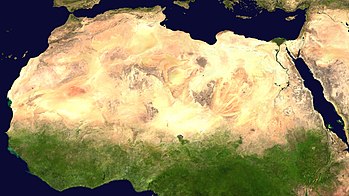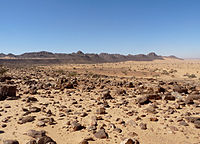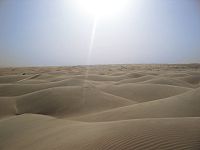|
Vikidia currently has 4,625 articles. Improve it! |
|
Join Vikidia: create your account now and improve it! |
Sahara
- This article is about the desert. The article about the country can be found at Western Sahara
The Sahara in North Africa, is the one of the largest deserts in the world. The Sahara has about the same size as the whole United States. It has been both larger and smaller at different times. After the last ice age it became more fertile, then dried up again. Most parts are uninhabited, but some people manage to survive in places where there is water.
It is the hottest place on the Earth, but the driest place is the Atacama Desert in South America.
Environment[edit | edit source]
It is bounded by the Atlantic Ocean, the Atlas Mountains, the Mediterranean Sea, the Red Sea, and the Sahel region. Inside it are parts of many countries, including Morocco, Algeria, Tunisia, Libya, Egypt, Mauritania, Mali, Niger, Chad, and The Sudan.
Landscapes in the Sahara[edit | edit source]
The highest mountain is 3415 m, and is the Emi Koussi in Chad. Some mountain peaks in the Sahara Desert have snow even in the summer. The main mountain ranges is the Atlas Mountains in Algeria. The Sahara's lowest point lies in the Qattara Depression in Egypt, at about 130 metres below sea level.
erg (landform)[edit | edit source]
An erg (also sand sea or dune sea, or sand sheet if it lacks dunes) is a broad, flat area of desert covered with wind-swept sand with little or no vegetative cover. An erg is defined as a desert area that contains more than 125 square kilometres (48 sq mi) of aeolian or wind-blown sand and where sand covers more than 20% of the surface. Smaller areas are known as "dune fields".
Sand seas and dune fields are about 25% of the Sahara.
Reg[edit | edit source]
It is a desert rocky surface.
see : reg or desert pavement
Rivers in the Sahara[edit | edit source]
There are several rivers running through the Sahara. However, most of them (wadis) come and go through the seasons, they flow only after rain, except for the Nile River and Niger River.
Minerals and hydrocarbons in the Sahara[edit | edit source]
Metallic minerals are very important to most Saharan countries. Algeria and Mauritania have several major deposits of iron ore. There are also bits of uranium, while Niger has the largest parts of them. A lot of phosphates are in Morocco and Western Sahara. Oil is mainly found in Algeria. The oil is very important to the economy of the entire country. While the mineral exploitation has led to economic growth in Sahara, this has rarely helped the indigenous population, as skilled workers have been brought from other countries.
Human life in the Sahara[edit | edit source]
Of the Sahara's around 4 million people, most live in Mauritania, Western Sahara, Algeria, Libya and Egypt. Dominant groups of people are Sahrawis, Tuareg and Negroids. The largest city is Nouakchott, Mauritania's capital. Other important cities are Tamanrasset in Algeria, and Sebha and Ghat in Libya.
The soil in Sahara is low in organic matter. The soil in depressions is often saline.Only 200,000 km² of Sahara are fertile oases, where dates, corn, and fruits are grown. The few fertile regions today are fed by underground rivers and underground basins. Many of Sahara's oases rests in depressions (areas under sea level) allowing water to surface from underground reservoirs; artesian wells.
Fauna and flora of the Sahara[edit | edit source]
Animal life is limited to gazelles, antelopes, jackals, sand foxes, badgers and hyena. Animal life of Sahara include gerbil, jerboa, cape hare and desert hedgehog, barbary sheep, oryx, deer, wild ass, weasel and mongoose. The bird life counts more than 300 species.
Other sorts of vegetation include scattered concentrations of grasses, shrubs and trees in the highlands, as well as in the oases and along river beds. Some plants are well adjusted to the climate, allowing them to germinate within 3 days of rain and sow their seeds within 2 weeks after that.
References and notes[edit | edit source]
Adapted from the Simple English Wikipedia: Sahara [1]
Other websites[edit | edit source]
- in French Flora and fauna of the Sahara
| Geography Portal — Everything about geography, continents, regions, geology, water and climate... |





